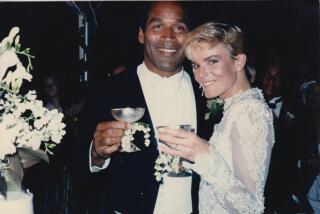THE O.J. SIMPSON MURDER TRIAL
- Share via
UCLA law professor Peter Arenella and Loyola University law professor Laurie Levenson offer their take on the Simpson trial. Joining them is Los Angeles defense attorney Marcia Morrissey, who will rotate with other experts as the case moves forward. Today’s topic: parking problems.
PETER ARENELLA
On the prosecution: Paradoxically, for a case that ultimately may hinge on the reliability of DNA technology, the prosecution once again relied on a man walking his dog to end the time-line portion of its case. If the jury believes Charles Cale’s testimony that there was no white Bronco parked on Rockingham between 9:30 and 9:45 p.m., and combines it with the limo driver’s recollection concerning the Bronco’s absence between 10:22 and 10:37, then Simpson is in trouble.
On the defense: Robert Shapiro’s cross-examination may have strengthened the prosecution’s time-line evidence. By pointing out that Cale did not see Simpson and Kato’s return from McDonald’s at 9:30, he may have left the jury with the impression that Kale noticed the Bronco’s absence closer to 9:45 than 9:30. Shapiro has to hope that jurors are put off by this affluent, Brentwood neighbor with his punctilious view of what constitutes appropriate parking.
LAURIE LEVENSON
On the prosecution: The prosecutors are nailing down the fact that Simpson’s Bronco was not parked outside his home during the critical time on the night of the murders. Cale’s testimony, therefore, helped undermine the defense claim that Simpson was at home playing golf in his front yard when the murders occurred. Cale’s low-key performance on direct didn’t make much of a splash, but Shapiro’s cross-examination emphasized its importance.
On the defense: Shapiro made the mistake of taking personally Cale’s decision not to call him back because he was sick in bed. He was too hostile in his cross-examination. The net result is that Shapiro turned the testimony of a straightforward witness into what sounded like crucial evidence. Shapiro seemed to be on course when he asked Cale why he waited to come forward, but Cale explained he was provoked by the claim that the police moved the Bronco.
MARCIA MORRISSEY
On the prosecution: The prosecution came up with its predictable Friday surprise. This time they summoned from his sickbed Simpson’s neighbor, Cale, to make a preemptive strike at Rosa Lopez--a witness the jury may never hear. Cale’s evidentiary value was marginal, but he certainly was newsworthy, which frequently determines the prosecution’s order of witnesses. They continue to react to the defense rather than put on their own case.
On the defense: Highly publicized cases attract witnesses and the most highly publicized case in history brings them out in hordes. Cale’s sudden appearance, six months after the fact in response to media reports about Simpson’s prospective defense, provides ample grounds for the defense to challenge his tardy recollection, as well as his ability to remember not seeing car during a 15-minute dog walk in his neighborhood more than half a year ago.
Compiled by TIM RUTTEN / Los Angeles Times
More to Read
Sign up for Essential California
The most important California stories and recommendations in your inbox every morning.
You may occasionally receive promotional content from the Los Angeles Times.













